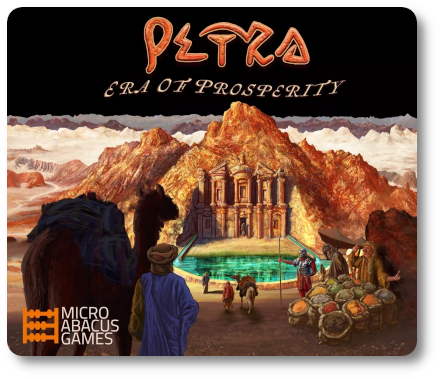 The Basics:
The Basics:
- For ages 10 and up (publisher suggests 12+)
- For 1 to 4 players
- Approximately 60 minutes to complete
Geek Skills:
- Active Listening & Communication
- Counting & Math
- Logical & Critical Decision Making
- Strategy & Tactics
- Risk vs. Reward
- Visuospatial Skills
- Hand/Resource Management
Learning Curve:
- Child – Easy
- Adult – Easy
Theme & Narrative:
- Help build the Great City of Petra and bring wealth to the land and your tribe
Endorsements:
- Gamer Geek approved!
- Parent Geek approved!
- Child Geek approved!
Overview
The Great City of Petra was established by road-harden nomadic traders who wanted to end their wandering to create a central trading hub. It would quickly become the center of trade in the region and earn those who wandered its streets and dealt in the markets great wealth and influence. But this is not the story of Petra as it was, but how Petra might have come to be. Take command of your nomadic tribe and guide your camels across the desert to create trade routes, build monuments, and secure a future for the great city yet to be. All will live in prosperity once Petra is built, but only one tribe will significantly contribute to the city’s success.
Petra: Era of Prosperity, designed by Benjamin Baker and published by Micro Abacus Games, is comprised of one Time card, four Goal cards, 11 Journey cards, 12 Map cards, four Reference cards, four Player cards (although our copy came with five), two standard six-sided dice, one standard eight-sided die, one King Aretas card (used when playing the game solo), and four common dry-erase markers. The component quality is excellent, with the cards being thick and durable. Illustrations by Radu Paul Mazanec are well done and further the game’s theme and narrative. Not included with the game, but necessary to play, is a few tissues for each player to erase their dry-eraser marks when making corrections and updates.
Hitch Your Camel
Complete the following steps to set up a standard game.
- Find and place the Time card on one side of the game-playing area. Place the dice next to the Time card.
- Find the Goal cards. Players may randomly select one or choose a specific Goal card for the game. Place the selected Goal card next to the Time card, returning unused Goal cards to the game’s box.
- Find and shuffle the Map cards. Do the same with the Journey cards. Place the Journey cards face-down off to one side of the game-playing area, making sure you leave room for a discard pile. This is the Journey card draw deck for the duration of the game. Place the Map cards next to the Journey cards. The Map cards are double-sided. No one particular side should or should not be showing. This is the Map draw deck for the duration of the game.
- Determine who will be the first player using whatever means is most popular with your group.
- Starting with the first player and going in turn order sequence clockwise around the table, have each player complete the following:
- Select a Player card and the matching colored dry-erase marker. Note that each Player card has a special ability available to only that player.
- Draw the top-most Map card, choose either side, and place it to the center of the playing area, either starting the map or placing the Map card next to another to create a larger map area.
- Draw the player’s colony shape (as noted on their Player card) on the red Colonization dot on their selected and placed Map card. After this, the player may draw two separate “exploration lines” originating from their colonization dot.
After all players have completed their initial setup, the game can begin!
Player Special Abilities and the Goal Card
Each of the Player cards is used to keep track of three things. First, the unique symbol that belongs to the player and is used to mark spaces on the Map cards. Second, to keep track of resources and points earned, spent, or lost during the game. Third, to remind the player of their special ability.
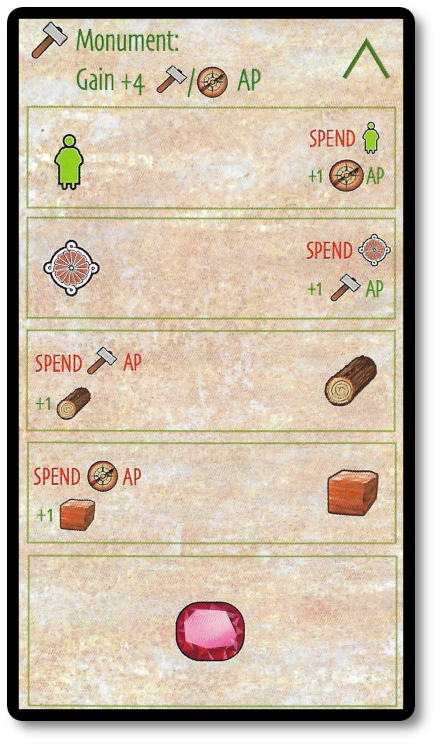
The Goal card determines when additional points are earned. Players earn points, Population, and Influence during the game based on what they are building or connecting two. The Goal card provides additional opportunities to earn points. For example, “The Nabataeon People” Goal card awards players extra points at the end of “The Thriving City” round (round 3), “Building Temples” round (round five), and “Final Construction” round (round seven). Additionally, it gives additional directions on scoring points at the end of the game.
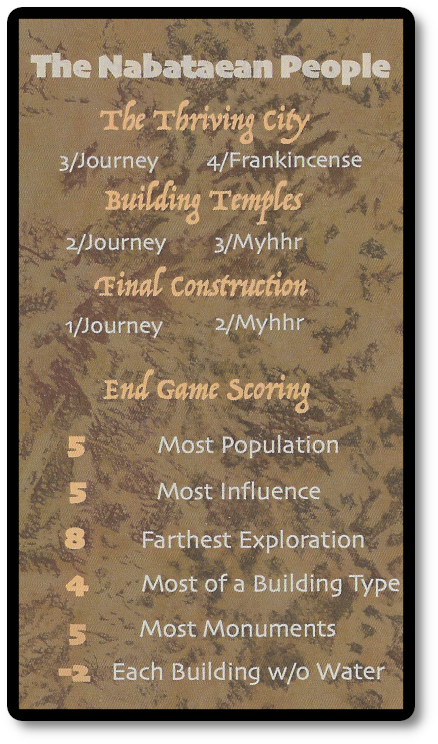
Going Nomad
Petra: Era of Prosperity is played in turns and rounds for no more than eight rounds per game. Each round is approximately 50 years (in game narrative terms), which includes exploration and advances in population development. The rounds and the thematic span of years being played are tracked on the Time card, starting with the top “The Nabataeans” and ending in the bottom “Decline and Fall.”
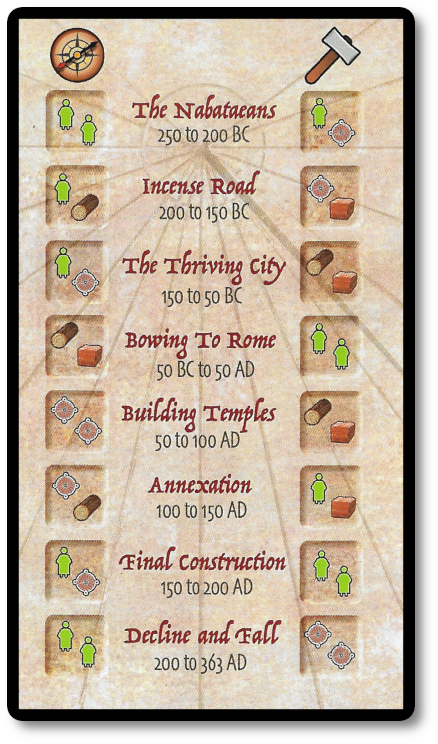
A player’s turn is summarized here.
Note: During a player’s turn, they are called the “active player.” The next player in the turn order sequence is named the “inactive player.” In this way, on a player’s turn, two people will take action while any other players wait their turn.
Step One: Active Player Rolls the Dice and Places
The active player takes the two six-sided dice, rolls them, and selects one of the two to use, placing it on the left or right side of the Time card. The leftmost column of the Time card represents exploration, wherein the player can explore, gather stones, journey, or conlize. The right-most side column of the Time card represents building, wherein players can build water conduits, gather wood, and build farms or other buildings.
If the active player rolled two dice of the same value (two “5’s,” for example) or the total value of the summed numbers rolled on the two dice is equal to or less than four (for example, a rolled value of “1” and “2”), they re-roll the dice.
When the active player places their selected die, they put it on the side of the Time card that represents the actions they want to take that turn. The number of actions a player has on their turn is named “action points.” The number of action points a player has on their turn equals the die value they use. For example, a die roll of four would give the player four action points to spend on their turn.
Finally, one last important detail. If the active player elects to use the lowered value of the two dice rolled, they get the bonus noted in the square space of the current round’s row in the column they selected. Extras include Population, Influence, Wood, and Stone. These are kept track of on the Player card.
The dice not selected by the active player belong to the inactive player. The inactive player now places that die in the other row. The inactive player may take action points for the associated column (Explore or Build) or gain bonuses. Never both.
Step Two: Spend Action Points
Both the active and the inactive player will now spend their action points. This can be done simultaneously, but the active player always gets priority if there is a conflict.
Players will naturally earn action points by rolling the dice. They can also earn action points for spending Population or Influence. There are two types of actions: basic and special.
Basic actions include the following and cost one action point:
- Explore (Exploration action): For each action point spent, the player may draw one line on a Map card originating from a colony or a previously drawn exploration line. When drawing lines, draw only one space at a time. A space equals the single distance between intersections of the Map card gridlines.
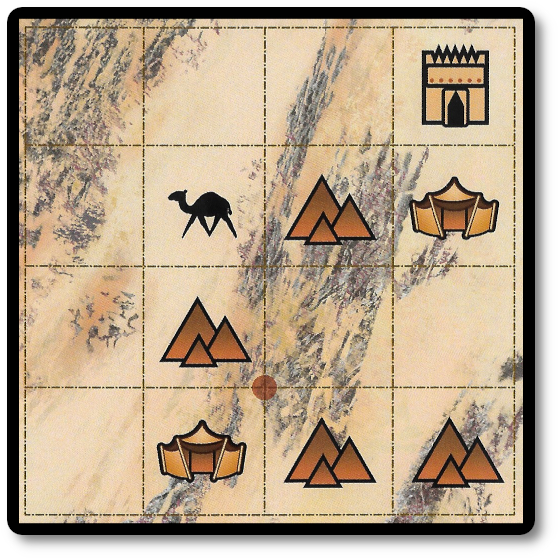
- Gather Stone (Exploration action): Obtain one additional Stone resource.
- Water Conduit (Building action): draw one squiggly line on any space on the Map card with a mountain icon.
- Buildings (Building action): Mark a building on the Map card with the player’s unique shape (found on their Player card), pay the resource cost (wood, stone, or a combination of the two), and gain the indicated bonus. Note that the player must have been able to travel to the building (via their exploration line) to mark a building.
- Farms (Building action): Mark any open space on the Map card that is accessible to the player’s exploration line and write an “F” (for a frankincense farm) or an “M” (for a myhhr farm). Players can build a farm on a space with a mountain, but it will cost them one additional action point.
- Gather Wood (Building action): Obtain one additional Wood resource.
Special actions include the following and cost two action points:
- Journey (Exploration action): Allows the player to go on a journey to find additional riches and trade routes. More on this in a moment.
- Colonize (Exploration action): Mark an open red dot on a Map card with the player’s unique symbol.
After each player has spent their action points, the turn is over. The inactive player is now the active player and rolls the dice. The round ends once every player has had an opportunity to be the active player once (which means each player will also have a chance to be the inactive player once).
If the last active player completes their turn on the eighth and final round or any player builds their fourth monument, the game ends, and the final score is determined. If not, a new round now begins.
Going On Journeys
Journeys allow the player to play through a small side quest on their turn that requires a bit of risk but could earn the player a big reward. When the player can reach the camel symbol on a Map card with their exploration line, they announce they are going on a Journey (which will cost them two action points).
The player then draws one of the Journey cards and takes the eight-sided die. Each Journey card has a starting position (noted by the camel icon) and a series of rows and columns connected by arrows. These arrows indicate the direction a player must take on their journey if they decide to move off their current row. Spaces with a gem will earn the player points. Spaces with a Wood or Stone icon will give the player one of that specific resource type. Spaces with a Roman helmet can only be entered and passed if the die value used for the current movement is of an equal or greater value. The spaces with an “x2” require the player to immediately go one additional space on their journey, but this does not count towards the total the player rolled.
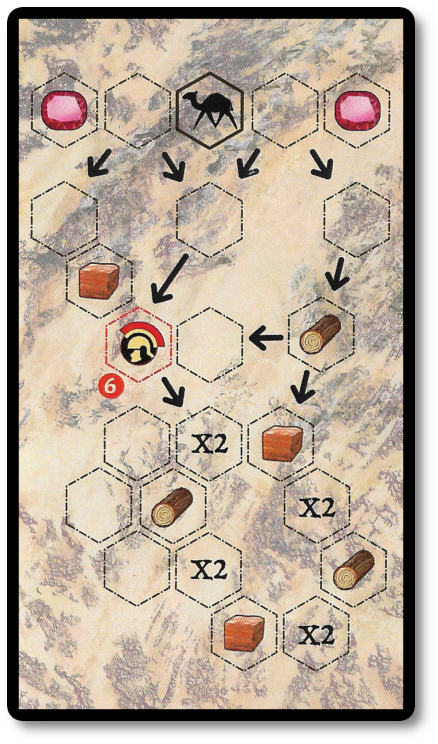
Every journey the player takes is one of possible great discovery and riches or a disappointing trek that could lead to misfortune and lack of fortune. As soon as the player goes on their journey, they take the eight-sided die and roll it. The number value indicates the number of spaces the player will mark on the Journey card. After the player finishes drawing the number of spaces, if any are possible, one of three things can happen.
- The player busts. This happens when the player cannot continue – that is to say, cannot mark a space on the journey card – given the required number of spaces they must travel as indicated by their dice roll. The player can gain nothing or lose three points and earn all the resources they encountered on their journey.
- The player stops. Even though they could continue their journey (with risk), the player decides that “enough is enough” and ends their adventure. The player collects any points and resources they encountered on their journey, recording them to their Player card.
- The player continues. The player pushes their luck and rolls the eight-sided die again. They continue their journey where they last left off.
Ending Your Travels
The game ends in the eighth round after all players have had an opportunity to be active players or any player has built a fourth Monument. The end-game score is now determined using the Goal card. The player with the most points wins the game.
Game Variant
Petra: Era of Prosperity is best played with others, in my opinion, but if you don’t have anyone to play with, you can still enjoy the game. The box includes a solo variant where the player will compete against King Aretas, who takes a predefined path and types of actions each round. Interestingly enough, King Aretas can be introduced as another player in the game even if you already have the maximum number of four players. The good king was surprisingly good at earning points. He kept our solo rollers busy and introduced some exciting decision-making for our players when the monarch decided to grace the table with his presence.
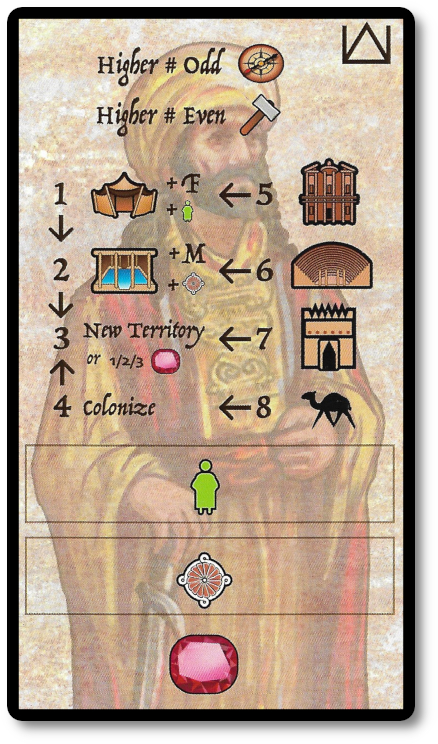
To learn more about Petra: Era of Prosperity, visit the game’s web page.
Final Word
 The Child Geeks had a lot of fun playing this game and did a great job navigating the maps and the many different ways to earn points. It turns out that a player can compete and have a wonderful time just by going towards what they find the most interesting or whatever is closest to their exploration path. Compete, but not always win. Whether the Child Geeks won or lost, they always had good things to say. One Child Geek said, “I really liked this game because it let me explore and build my own paths across the maps.” Another Child Geek reported, “Each time I was able to draw on the cards I felt like I was really exploring the dessert and building cities for people.” When the last camel returned, the Child Geeks took a vote, and all agreed that Petra: Era of Prosperity was well worth their time.
The Child Geeks had a lot of fun playing this game and did a great job navigating the maps and the many different ways to earn points. It turns out that a player can compete and have a wonderful time just by going towards what they find the most interesting or whatever is closest to their exploration path. Compete, but not always win. Whether the Child Geeks won or lost, they always had good things to say. One Child Geek said, “I really liked this game because it let me explore and build my own paths across the maps.” Another Child Geek reported, “Each time I was able to draw on the cards I felt like I was really exploring the dessert and building cities for people.” When the last camel returned, the Child Geeks took a vote, and all agreed that Petra: Era of Prosperity was well worth their time.
 The Parent Geeks also had nothing bad to say about the game. They found it an enjoyable puzzle to solve, an exploration to dive into, and an adventure of critical decision-making. One Parent Geek states, “I’m enjoying this new wave of roll-and-write games released in the last couple of years, and this game is my current favorite. Every game feels different with the random cards that come out, the journeys you take feel like little sidequests that are worth it, and the fierce competition, with an outstanding balance between risk and reward. Honestly, I couldn’t ask for anything more!” Another Parent Geek said, “So far, my favorite game to play with my family this month. It engages you and has you thinking both creatively and strategically. I very much recommend it.” When the monuments were built, the Parent Geeks evaluated their work and found Petra: Era of Prosperity to be outstanding.
The Parent Geeks also had nothing bad to say about the game. They found it an enjoyable puzzle to solve, an exploration to dive into, and an adventure of critical decision-making. One Parent Geek states, “I’m enjoying this new wave of roll-and-write games released in the last couple of years, and this game is my current favorite. Every game feels different with the random cards that come out, the journeys you take feel like little sidequests that are worth it, and the fierce competition, with an outstanding balance between risk and reward. Honestly, I couldn’t ask for anything more!” Another Parent Geek said, “So far, my favorite game to play with my family this month. It engages you and has you thinking both creatively and strategically. I very much recommend it.” When the monuments were built, the Parent Geeks evaluated their work and found Petra: Era of Prosperity to be outstanding.
 The Gamer Geeks dived right in and had a hard time diving out. They were heavily engaged and exceedingly competitive, taking risks in journies to get those extra points and ranging far and wide to expand their reach and influence in the desert. They found the game’s mix of strategy and tactics to be beautifully complimented by the game’s risk and reward. One Gamer Geek said, “This is the kind of game I will always gravitate to. It gives players a new game and challenges each time they play, asks them to take calculated risks constantly, and never once feel bored or disengaged. I very much and highly approve.” Another Game Geek said, “An excellent roll-and-write game that fits perfectly between the casual lighter games and the slightly heavier games. It worked great as a filler and was just as welcomed to the table as the main game of the evening. Great stuff.” When the great city of Petra was finally built, all the Gamer Geeks eagerly moved in and cheered.
The Gamer Geeks dived right in and had a hard time diving out. They were heavily engaged and exceedingly competitive, taking risks in journies to get those extra points and ranging far and wide to expand their reach and influence in the desert. They found the game’s mix of strategy and tactics to be beautifully complimented by the game’s risk and reward. One Gamer Geek said, “This is the kind of game I will always gravitate to. It gives players a new game and challenges each time they play, asks them to take calculated risks constantly, and never once feel bored or disengaged. I very much and highly approve.” Another Game Geek said, “An excellent roll-and-write game that fits perfectly between the casual lighter games and the slightly heavier games. It worked great as a filler and was just as welcomed to the table as the main game of the evening. Great stuff.” When the great city of Petra was finally built, all the Gamer Geeks eagerly moved in and cheered.
 Petra: Era of Prosperity is a real winner.
Petra: Era of Prosperity is a real winner.
My only complaint is the game’s rule book. It’s missing some words, doesn’t introduce important game concepts with enough clarity to allow the players to jump in with complete confidence, and seems to gloss over a few key areas that should have more in-depth exploration and visual explanation. That said, the game was not challenging to understand and easy to teach. Our most skilled players and our youngest had no problems understanding and enjoying themselves. The loudest grumbling I ever heard was when players accidentally erased another player’s mark or marked it too big on the card.
Now that we have the negative out of the way, let’s focus on the positive, and there are a lot of positives to discuss. The game is fast, and each action point spent is worth taking the time to consider how best to use it. Games are tight; managing outcomes can sometimes feel like multi-turn processes. However, that is fully intended, as each player can also engage in the game as inactive, setting themselves up for a decisive turn. Resources in the game are scarce but can be obtained through thoughtful navigation and taking risks through journies, which are very, very much worth going on and introduce a fun sidequest aspect of the game that challenges the player to think differently, jumping into a mini-game.
It was simply excellent and enjoyed by all who had a chance to play it. Petra: Era of Prosperity is one of my favorite roll-and-write games due to its depth, creativity, and risk-taking that blends all the aspects of the entire gameplay into a cohesive, engaging experience on multiple levels. Do play this fun game at your family gaming table when time permits. Take the journey and explore the desert. You’ll find riches without much trouble.
This game was given to Father Geek as a review copy. Father Geek was not paid, bribed, wined, dined, or threatened in vain hopes of influencing this review. Such is the statuesque and legendary integrity of Father Geek.



